EEG Report: Bio-Medical Instrumentation, Digital Filter in MATLAB
VerifiedAdded on 2023/01/17
|14
|3270
|46
Report
AI Summary
This report provides a comprehensive overview of electroencephalography (EEG), delving into its fundamental principles, measurement techniques, and practical applications. It begins by exploring the different types of brain waves associated with EEG signals, detailing their characteristics and significance in understanding brain states. The report then discusses various electrode types, including bipolar and unipolar configurations, and their respective measurement methods. A significant portion of the report focuses on the design and implementation of a digital filter, specifically an IIR Butterworth filter, using the MATLAB platform. This filter is designed to remove unwanted noise interference that can affect EEG recordings during diagnosis and treatment. The report includes discussions on the transfer function, difference equations, and filter realization, along with simulation results, including pole-zero plots and response curves. The design exercise highlights the importance of sampling frequency and Nyquist's theorem for accurate signal acquisition. Overall, the report provides a valuable resource for understanding the principles of EEG and its practical application in biomedical instrumentation.
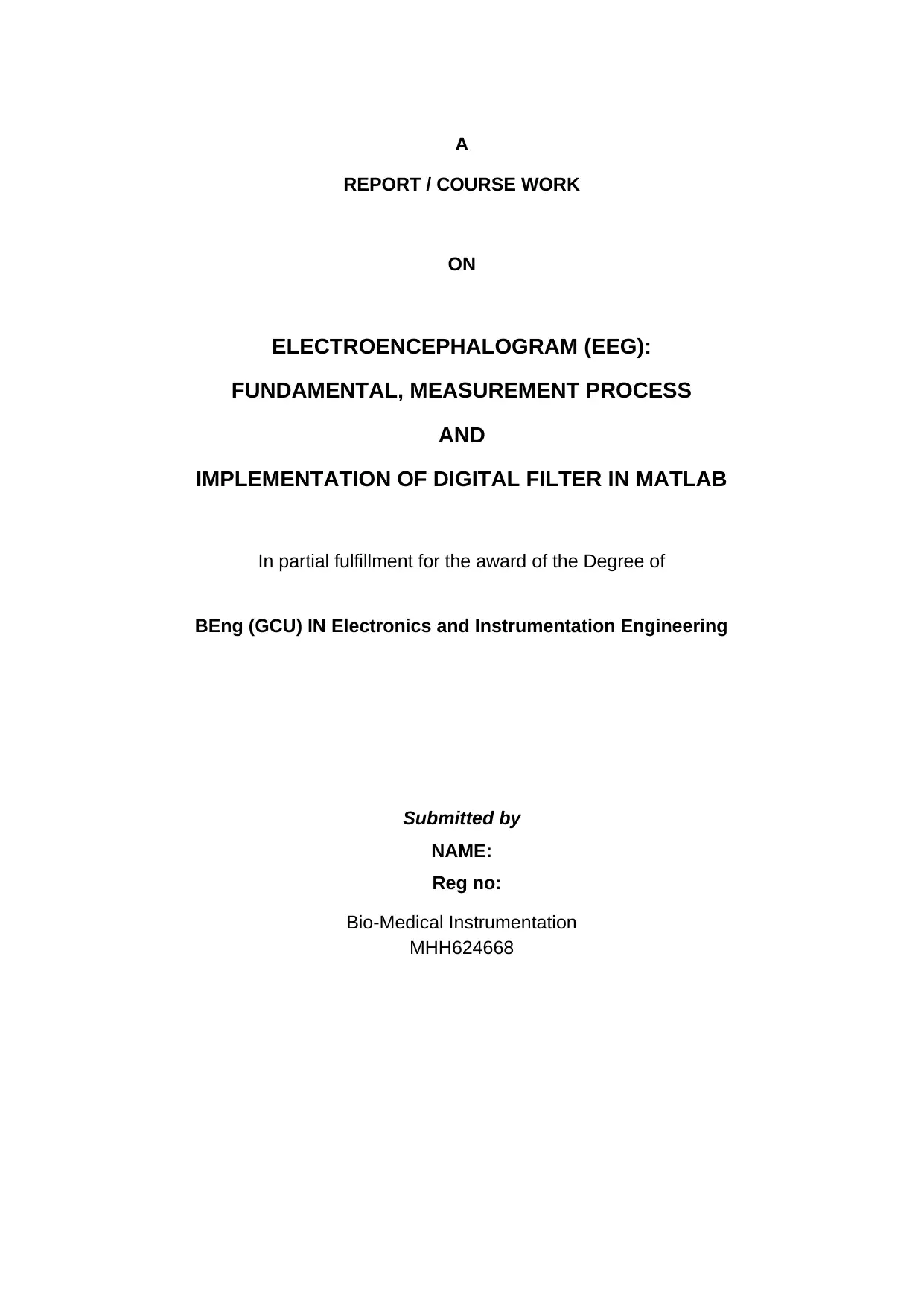
A
REPORT / COURSE WORK
ON
ELECTROENCEPHALOGRAM (EEG):
FUNDAMENTAL, MEASUREMENT PROCESS
AND
IMPLEMENTATION OF DIGITAL FILTER IN MATLAB
In partial fulfillment for the award of the Degree of
BEng (GCU) IN Electronics and Instrumentation Engineering
Submitted by
NAME:
Reg no:
Bio-Medical Instrumentation
MHH624668
REPORT / COURSE WORK
ON
ELECTROENCEPHALOGRAM (EEG):
FUNDAMENTAL, MEASUREMENT PROCESS
AND
IMPLEMENTATION OF DIGITAL FILTER IN MATLAB
In partial fulfillment for the award of the Degree of
BEng (GCU) IN Electronics and Instrumentation Engineering
Submitted by
NAME:
Reg no:
Bio-Medical Instrumentation
MHH624668
Paraphrase This Document
Need a fresh take? Get an instant paraphrase of this document with our AI Paraphraser

ACKNOWLEDGEMENT
I would like to express my sincere gratitude and appreciation to my supervisor NAME,
DESIGNATION for guiding me throughout all my course work technically and
methodologically.
I would like to thank all the teaching and non-teaching staffs of Dept and Institute name, for
providing enormous support to carry out my research works. I would like to thank all my
colleagues of Institute name, for providing their support in various manners during my course
works.
I would like to express my sincere gratitude and appreciation to my supervisor NAME,
DESIGNATION for guiding me throughout all my course work technically and
methodologically.
I would like to thank all the teaching and non-teaching staffs of Dept and Institute name, for
providing enormous support to carry out my research works. I would like to thank all my
colleagues of Institute name, for providing their support in various manners during my course
works.
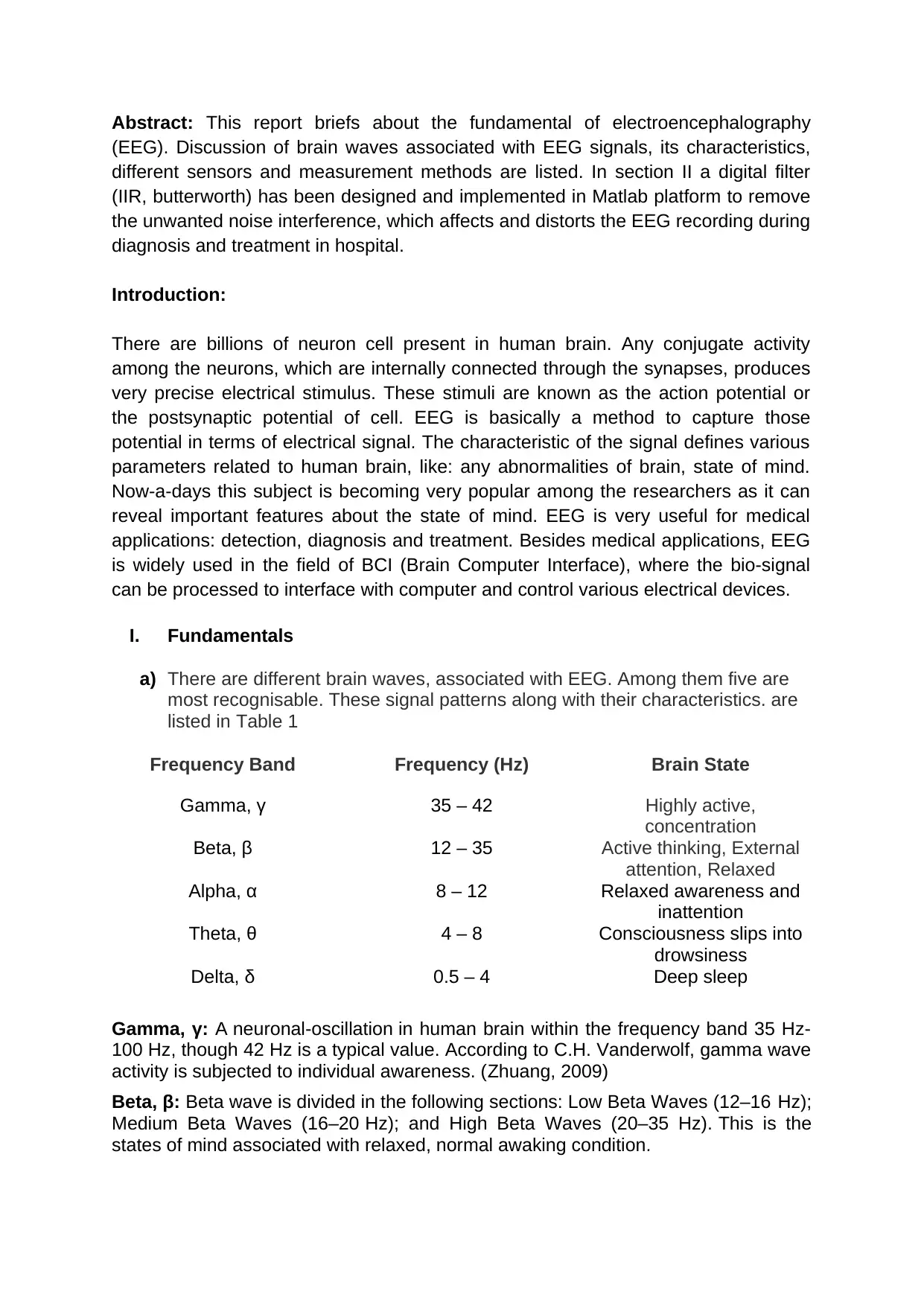
Abstract: This report briefs about the fundamental of electroencephalography
(EEG). Discussion of brain waves associated with EEG signals, its characteristics,
different sensors and measurement methods are listed. In section II a digital filter
(IIR, butterworth) has been designed and implemented in Matlab platform to remove
the unwanted noise interference, which affects and distorts the EEG recording during
diagnosis and treatment in hospital.
Introduction:
There are billions of neuron cell present in human brain. Any conjugate activity
among the neurons, which are internally connected through the synapses, produces
very precise electrical stimulus. These stimuli are known as the action potential or
the postsynaptic potential of cell. EEG is basically a method to capture those
potential in terms of electrical signal. The characteristic of the signal defines various
parameters related to human brain, like: any abnormalities of brain, state of mind.
Now-a-days this subject is becoming very popular among the researchers as it can
reveal important features about the state of mind. EEG is very useful for medical
applications: detection, diagnosis and treatment. Besides medical applications, EEG
is widely used in the field of BCI (Brain Computer Interface), where the bio-signal
can be processed to interface with computer and control various electrical devices.
I. Fundamentals
a) There are different brain waves, associated with EEG. Among them five are
most recognisable. These signal patterns along with their characteristics. are
listed in Table 1
Frequency Band Frequency (Hz) Brain State
Gamma, γ 35 – 42 Highly active,
concentration
Beta, β 12 – 35 Active thinking, External
attention, Relaxed
Alpha, α 8 – 12 Relaxed awareness and
inattention
Theta, θ 4 – 8 Consciousness slips into
drowsiness
Delta, δ 0.5 – 4 Deep sleep
Gamma, γ: A neuronal-oscillation in human brain within the frequency band 35 Hz-
100 Hz, though 42 Hz is a typical value. According to C.H. Vanderwolf, gamma wave
activity is subjected to individual awareness. (Zhuang, 2009)
Beta, β: Beta wave is divided in the following sections: Low Beta Waves (12–16 Hz);
Medium Beta Waves (16–20 Hz); and High Beta Waves (20–35 Hz). This is the
states of mind associated with relaxed, normal awaking condition.
(EEG). Discussion of brain waves associated with EEG signals, its characteristics,
different sensors and measurement methods are listed. In section II a digital filter
(IIR, butterworth) has been designed and implemented in Matlab platform to remove
the unwanted noise interference, which affects and distorts the EEG recording during
diagnosis and treatment in hospital.
Introduction:
There are billions of neuron cell present in human brain. Any conjugate activity
among the neurons, which are internally connected through the synapses, produces
very precise electrical stimulus. These stimuli are known as the action potential or
the postsynaptic potential of cell. EEG is basically a method to capture those
potential in terms of electrical signal. The characteristic of the signal defines various
parameters related to human brain, like: any abnormalities of brain, state of mind.
Now-a-days this subject is becoming very popular among the researchers as it can
reveal important features about the state of mind. EEG is very useful for medical
applications: detection, diagnosis and treatment. Besides medical applications, EEG
is widely used in the field of BCI (Brain Computer Interface), where the bio-signal
can be processed to interface with computer and control various electrical devices.
I. Fundamentals
a) There are different brain waves, associated with EEG. Among them five are
most recognisable. These signal patterns along with their characteristics. are
listed in Table 1
Frequency Band Frequency (Hz) Brain State
Gamma, γ 35 – 42 Highly active,
concentration
Beta, β 12 – 35 Active thinking, External
attention, Relaxed
Alpha, α 8 – 12 Relaxed awareness and
inattention
Theta, θ 4 – 8 Consciousness slips into
drowsiness
Delta, δ 0.5 – 4 Deep sleep
Gamma, γ: A neuronal-oscillation in human brain within the frequency band 35 Hz-
100 Hz, though 42 Hz is a typical value. According to C.H. Vanderwolf, gamma wave
activity is subjected to individual awareness. (Zhuang, 2009)
Beta, β: Beta wave is divided in the following sections: Low Beta Waves (12–16 Hz);
Medium Beta Waves (16–20 Hz); and High Beta Waves (20–35 Hz). This is the
states of mind associated with relaxed, normal awaking condition.
⊘ This is a preview!⊘
Do you want full access?
Subscribe today to unlock all pages.

Trusted by 1+ million students worldwide
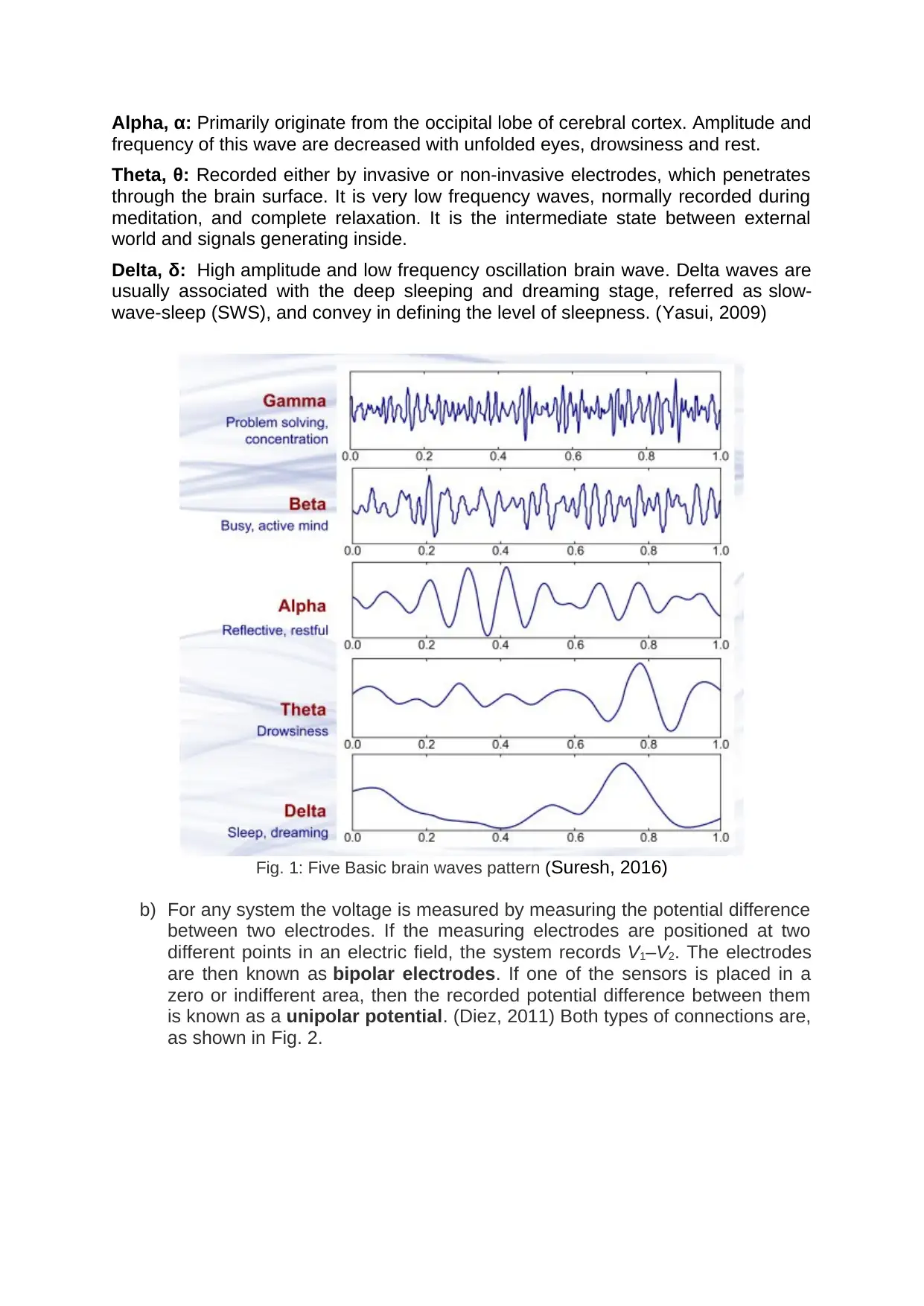
Alpha, α: Primarily originate from the occipital lobe of cerebral cortex. Amplitude and
frequency of this wave are decreased with unfolded eyes, drowsiness and rest.
Theta, θ: Recorded either by invasive or non-invasive electrodes, which penetrates
through the brain surface. It is very low frequency waves, normally recorded during
meditation, and complete relaxation. It is the intermediate state between external
world and signals generating inside.
Delta, δ: High amplitude and low frequency oscillation brain wave. Delta waves are
usually associated with the deep sleeping and dreaming stage, referred as slow-
wave-sleep (SWS), and convey in defining the level of sleepness. (Yasui, 2009)
Fig. 1: Five Basic brain waves pattern (Suresh, 2016)
b) For any system the voltage is measured by measuring the potential difference
between two electrodes. If the measuring electrodes are positioned at two
different points in an electric field, the system records V1–V2. The electrodes
are then known as bipolar electrodes. If one of the sensors is placed in a
zero or indifferent area, then the recorded potential difference between them
is known as a unipolar potential. (Diez, 2011) Both types of connections are,
as shown in Fig. 2.
frequency of this wave are decreased with unfolded eyes, drowsiness and rest.
Theta, θ: Recorded either by invasive or non-invasive electrodes, which penetrates
through the brain surface. It is very low frequency waves, normally recorded during
meditation, and complete relaxation. It is the intermediate state between external
world and signals generating inside.
Delta, δ: High amplitude and low frequency oscillation brain wave. Delta waves are
usually associated with the deep sleeping and dreaming stage, referred as slow-
wave-sleep (SWS), and convey in defining the level of sleepness. (Yasui, 2009)
Fig. 1: Five Basic brain waves pattern (Suresh, 2016)
b) For any system the voltage is measured by measuring the potential difference
between two electrodes. If the measuring electrodes are positioned at two
different points in an electric field, the system records V1–V2. The electrodes
are then known as bipolar electrodes. If one of the sensors is placed in a
zero or indifferent area, then the recorded potential difference between them
is known as a unipolar potential. (Diez, 2011) Both types of connections are,
as shown in Fig. 2.
Paraphrase This Document
Need a fresh take? Get an instant paraphrase of this document with our AI Paraphraser
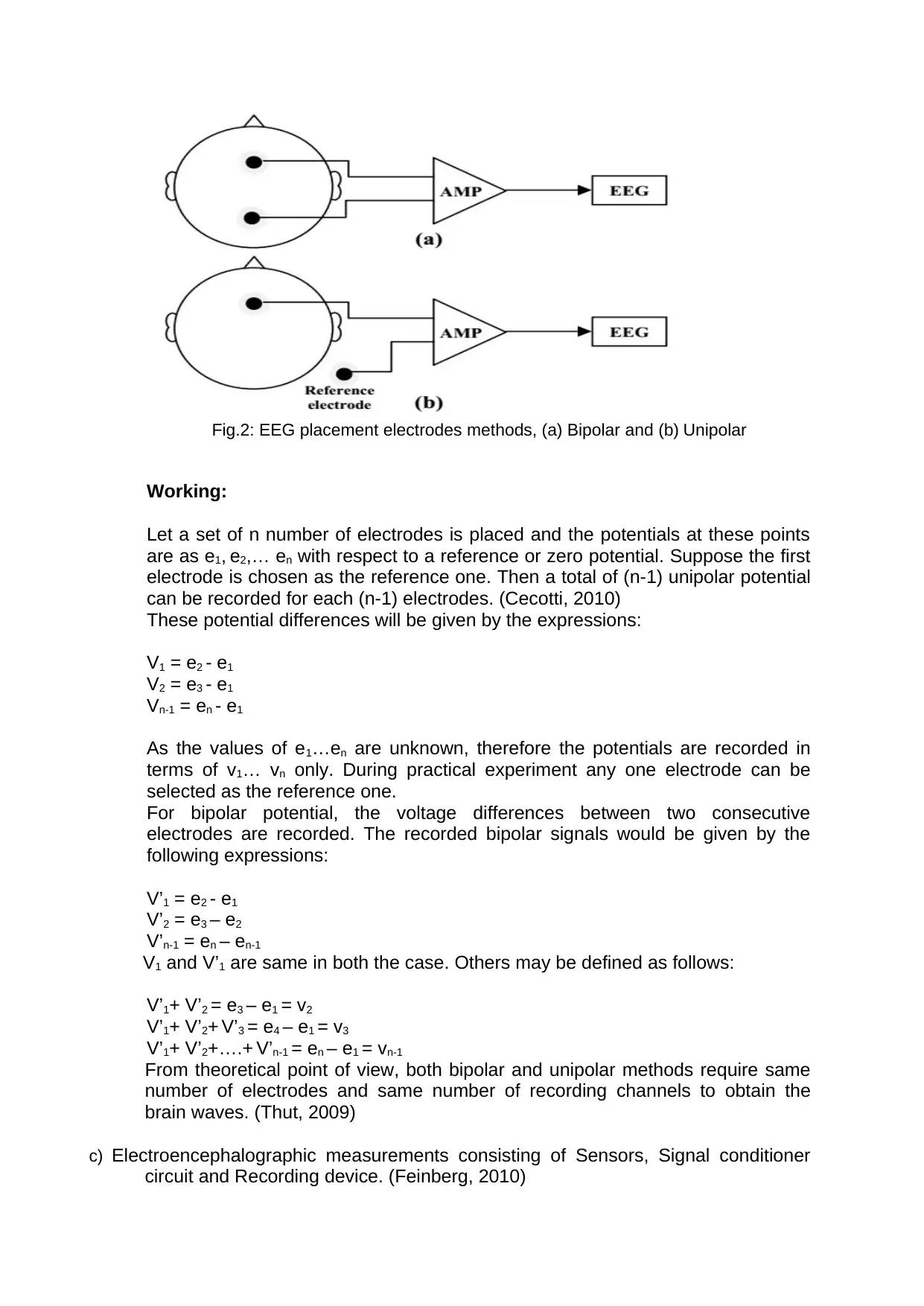
Fig.2: EEG placement electrodes methods, (a) Bipolar and (b) Unipolar
Working:
Let a set of n number of electrodes is placed and the potentials at these points
are as e1, e2,… en with respect to a reference or zero potential. Suppose the first
electrode is chosen as the reference one. Then a total of (n-1) unipolar potential
can be recorded for each (n-1) electrodes. (Cecotti, 2010)
These potential differences will be given by the expressions:
V1 = e2 - e1
V2 = e3 - e1
Vn-1 = en - e1
As the values of e1…en are unknown, therefore the potentials are recorded in
terms of v1… vn only. During practical experiment any one electrode can be
selected as the reference one.
For bipolar potential, the voltage differences between two consecutive
electrodes are recorded. The recorded bipolar signals would be given by the
following expressions:
V’1 = e2 - e1
V’2 = e3 – e2
V’n-1 = en – en-1
V1 and V’1 are same in both the case. Others may be defined as follows:
V’1+ V’2 = e3 – e1 = v2
V’1+ V’2+ V’3 = e4 – e1 = v3
V’1+ V’2+….+ V’n-1 = en – e1 = vn-1
From theoretical point of view, both bipolar and unipolar methods require same
number of electrodes and same number of recording channels to obtain the
brain waves. (Thut, 2009)
c) Electroencephalographic measurements consisting of Sensors, Signal conditioner
circuit and Recording device. (Feinberg, 2010)
Working:
Let a set of n number of electrodes is placed and the potentials at these points
are as e1, e2,… en with respect to a reference or zero potential. Suppose the first
electrode is chosen as the reference one. Then a total of (n-1) unipolar potential
can be recorded for each (n-1) electrodes. (Cecotti, 2010)
These potential differences will be given by the expressions:
V1 = e2 - e1
V2 = e3 - e1
Vn-1 = en - e1
As the values of e1…en are unknown, therefore the potentials are recorded in
terms of v1… vn only. During practical experiment any one electrode can be
selected as the reference one.
For bipolar potential, the voltage differences between two consecutive
electrodes are recorded. The recorded bipolar signals would be given by the
following expressions:
V’1 = e2 - e1
V’2 = e3 – e2
V’n-1 = en – en-1
V1 and V’1 are same in both the case. Others may be defined as follows:
V’1+ V’2 = e3 – e1 = v2
V’1+ V’2+ V’3 = e4 – e1 = v3
V’1+ V’2+….+ V’n-1 = en – e1 = vn-1
From theoretical point of view, both bipolar and unipolar methods require same
number of electrodes and same number of recording channels to obtain the
brain waves. (Thut, 2009)
c) Electroencephalographic measurements consisting of Sensors, Signal conditioner
circuit and Recording device. (Feinberg, 2010)
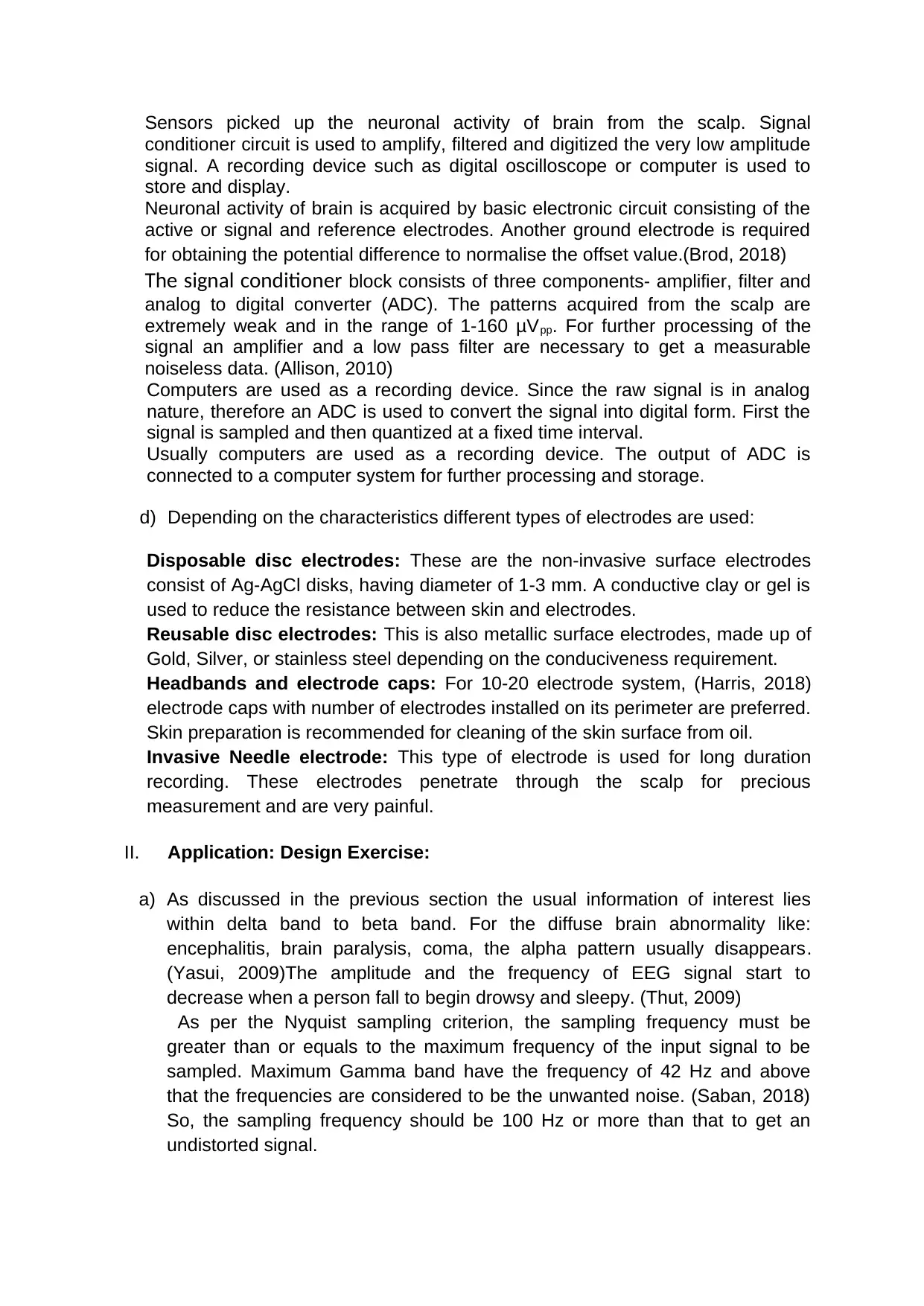
Sensors picked up the neuronal activity of brain from the scalp. Signal
conditioner circuit is used to amplify, filtered and digitized the very low amplitude
signal. A recording device such as digital oscilloscope or computer is used to
store and display.
Neuronal activity of brain is acquired by basic electronic circuit consisting of the
active or signal and reference electrodes. Another ground electrode is required
for obtaining the potential difference to normalise the offset value.(Brod, 2018)
The signal conditioner block consists of three components- amplifier, filter and
analog to digital converter (ADC). The patterns acquired from the scalp are
extremely weak and in the range of 1-160 μVpp. For further processing of the
signal an amplifier and a low pass filter are necessary to get a measurable
noiseless data. (Allison, 2010)
Computers are used as a recording device. Since the raw signal is in analog
nature, therefore an ADC is used to convert the signal into digital form. First the
signal is sampled and then quantized at a fixed time interval.
Usually computers are used as a recording device. The output of ADC is
connected to a computer system for further processing and storage.
d) Depending on the characteristics different types of electrodes are used:
Disposable disc electrodes: These are the non-invasive surface electrodes
consist of Ag-AgCl disks, having diameter of 1-3 mm. A conductive clay or gel is
used to reduce the resistance between skin and electrodes.
Reusable disc electrodes: This is also metallic surface electrodes, made up of
Gold, Silver, or stainless steel depending on the conduciveness requirement.
Headbands and electrode caps: For 10-20 electrode system, (Harris, 2018)
electrode caps with number of electrodes installed on its perimeter are preferred.
Skin preparation is recommended for cleaning of the skin surface from oil.
Invasive Needle electrode: This type of electrode is used for long duration
recording. These electrodes penetrate through the scalp for precious
measurement and are very painful.
II. Application: Design Exercise:
a) As discussed in the previous section the usual information of interest lies
within delta band to beta band. For the diffuse brain abnormality like:
encephalitis, brain paralysis, coma, the alpha pattern usually disappears.
(Yasui, 2009)The amplitude and the frequency of EEG signal start to
decrease when a person fall to begin drowsy and sleepy. (Thut, 2009)
As per the Nyquist sampling criterion, the sampling frequency must be
greater than or equals to the maximum frequency of the input signal to be
sampled. Maximum Gamma band have the frequency of 42 Hz and above
that the frequencies are considered to be the unwanted noise. (Saban, 2018)
So, the sampling frequency should be 100 Hz or more than that to get an
undistorted signal.
conditioner circuit is used to amplify, filtered and digitized the very low amplitude
signal. A recording device such as digital oscilloscope or computer is used to
store and display.
Neuronal activity of brain is acquired by basic electronic circuit consisting of the
active or signal and reference electrodes. Another ground electrode is required
for obtaining the potential difference to normalise the offset value.(Brod, 2018)
The signal conditioner block consists of three components- amplifier, filter and
analog to digital converter (ADC). The patterns acquired from the scalp are
extremely weak and in the range of 1-160 μVpp. For further processing of the
signal an amplifier and a low pass filter are necessary to get a measurable
noiseless data. (Allison, 2010)
Computers are used as a recording device. Since the raw signal is in analog
nature, therefore an ADC is used to convert the signal into digital form. First the
signal is sampled and then quantized at a fixed time interval.
Usually computers are used as a recording device. The output of ADC is
connected to a computer system for further processing and storage.
d) Depending on the characteristics different types of electrodes are used:
Disposable disc electrodes: These are the non-invasive surface electrodes
consist of Ag-AgCl disks, having diameter of 1-3 mm. A conductive clay or gel is
used to reduce the resistance between skin and electrodes.
Reusable disc electrodes: This is also metallic surface electrodes, made up of
Gold, Silver, or stainless steel depending on the conduciveness requirement.
Headbands and electrode caps: For 10-20 electrode system, (Harris, 2018)
electrode caps with number of electrodes installed on its perimeter are preferred.
Skin preparation is recommended for cleaning of the skin surface from oil.
Invasive Needle electrode: This type of electrode is used for long duration
recording. These electrodes penetrate through the scalp for precious
measurement and are very painful.
II. Application: Design Exercise:
a) As discussed in the previous section the usual information of interest lies
within delta band to beta band. For the diffuse brain abnormality like:
encephalitis, brain paralysis, coma, the alpha pattern usually disappears.
(Yasui, 2009)The amplitude and the frequency of EEG signal start to
decrease when a person fall to begin drowsy and sleepy. (Thut, 2009)
As per the Nyquist sampling criterion, the sampling frequency must be
greater than or equals to the maximum frequency of the input signal to be
sampled. Maximum Gamma band have the frequency of 42 Hz and above
that the frequencies are considered to be the unwanted noise. (Saban, 2018)
So, the sampling frequency should be 100 Hz or more than that to get an
undistorted signal.
⊘ This is a preview!⊘
Do you want full access?
Subscribe today to unlock all pages.

Trusted by 1+ million students worldwide

b) The transfer function describes the input-output relationship of the system in
the z-domain and the differential expression provides a discrete time domain
relation to compute the output of the system given a particular input. A
transfer function can easily be converted into a difference equation by
replacing bkz-k with bkx[n-k] and akz-k with aky[n-k]. Assuming the transfer
function’s region of convergence includes the unit circle, it can also be
converted into a Discrete Fourier Transform (DFT) by replacing z with ejw.
Transfer function:
H ( z )=
∑
k=0
N
bk z−k
1+∑
k=0
N
ak z−k
Difference equation:
y [ n ] =∑
k=0
N
bk x [ n−k ] −¿ ∑
k=0
N
ak y [n−k ]¿
The difference equation and transfer function can be broken down into several
individual terms:
• bk are constant numerator coefficients because they contribute to the
numerator of the transfer function.
• x[n-k] is the previous input sample to the filter, whereas k represents the
number of time delays.
• ak are constant denominator coefficients because they contribute to the
denominator of the transfer function.
• y[n] and y[n-k] are the present and previous input samples respectively to
the filter, whereas k represents the number of time delays.
• N is the order of the filter.
Filter Realization:
Digital filters may be realized in a variety of ways, depending on the
computation method of difference equation. The most straightforward
implementation of an IIR filter is called Direct Form I, where the difference
expression is defined as exactly as written without any intermediate
transformations.
the z-domain and the differential expression provides a discrete time domain
relation to compute the output of the system given a particular input. A
transfer function can easily be converted into a difference equation by
replacing bkz-k with bkx[n-k] and akz-k with aky[n-k]. Assuming the transfer
function’s region of convergence includes the unit circle, it can also be
converted into a Discrete Fourier Transform (DFT) by replacing z with ejw.
Transfer function:
H ( z )=
∑
k=0
N
bk z−k
1+∑
k=0
N
ak z−k
Difference equation:
y [ n ] =∑
k=0
N
bk x [ n−k ] −¿ ∑
k=0
N
ak y [n−k ]¿
The difference equation and transfer function can be broken down into several
individual terms:
• bk are constant numerator coefficients because they contribute to the
numerator of the transfer function.
• x[n-k] is the previous input sample to the filter, whereas k represents the
number of time delays.
• ak are constant denominator coefficients because they contribute to the
denominator of the transfer function.
• y[n] and y[n-k] are the present and previous input samples respectively to
the filter, whereas k represents the number of time delays.
• N is the order of the filter.
Filter Realization:
Digital filters may be realized in a variety of ways, depending on the
computation method of difference equation. The most straightforward
implementation of an IIR filter is called Direct Form I, where the difference
expression is defined as exactly as written without any intermediate
transformations.
Paraphrase This Document
Need a fresh take? Get an instant paraphrase of this document with our AI Paraphraser
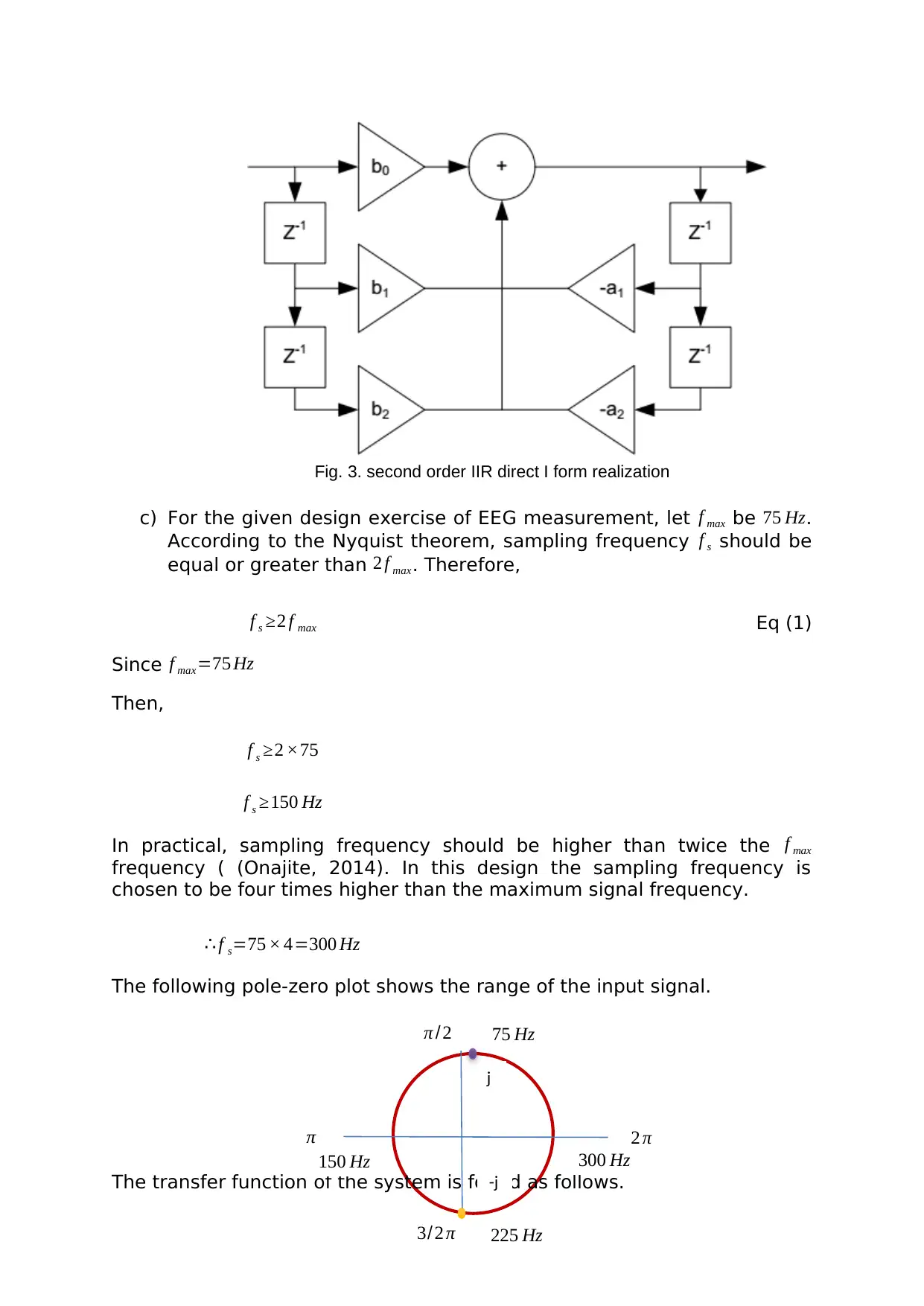
Fig. 3. second order IIR direct I form realization
c) For the given design exercise of EEG measurement, let f max be 75 Hz.
According to the Nyquist theorem, sampling frequency f s should be
equal or greater than 2 f max. Therefore,
f s ≥2 f max Eq (1)
Since f max=75 Hz
Then,
f s ≥2 ×75
f s ≥150 Hz
In practical, sampling frequency should be higher than twice the f max
frequency ( (Onajite, 2014). In this design the sampling frequency is
chosen to be four times higher than the maximum signal frequency.
∴ f s=75 × 4=300 Hz
The following pole-zero plot shows the range of the input signal.
The transfer function of the system is found as follows.
2 π
3/2 π
π
π / 2
300 Hz
75 Hz
150 Hz
225 Hz
j
-j
c) For the given design exercise of EEG measurement, let f max be 75 Hz.
According to the Nyquist theorem, sampling frequency f s should be
equal or greater than 2 f max. Therefore,
f s ≥2 f max Eq (1)
Since f max=75 Hz
Then,
f s ≥2 ×75
f s ≥150 Hz
In practical, sampling frequency should be higher than twice the f max
frequency ( (Onajite, 2014). In this design the sampling frequency is
chosen to be four times higher than the maximum signal frequency.
∴ f s=75 × 4=300 Hz
The following pole-zero plot shows the range of the input signal.
The transfer function of the system is found as follows.
2 π
3/2 π
π
π / 2
300 Hz
75 Hz
150 Hz
225 Hz
j
-j
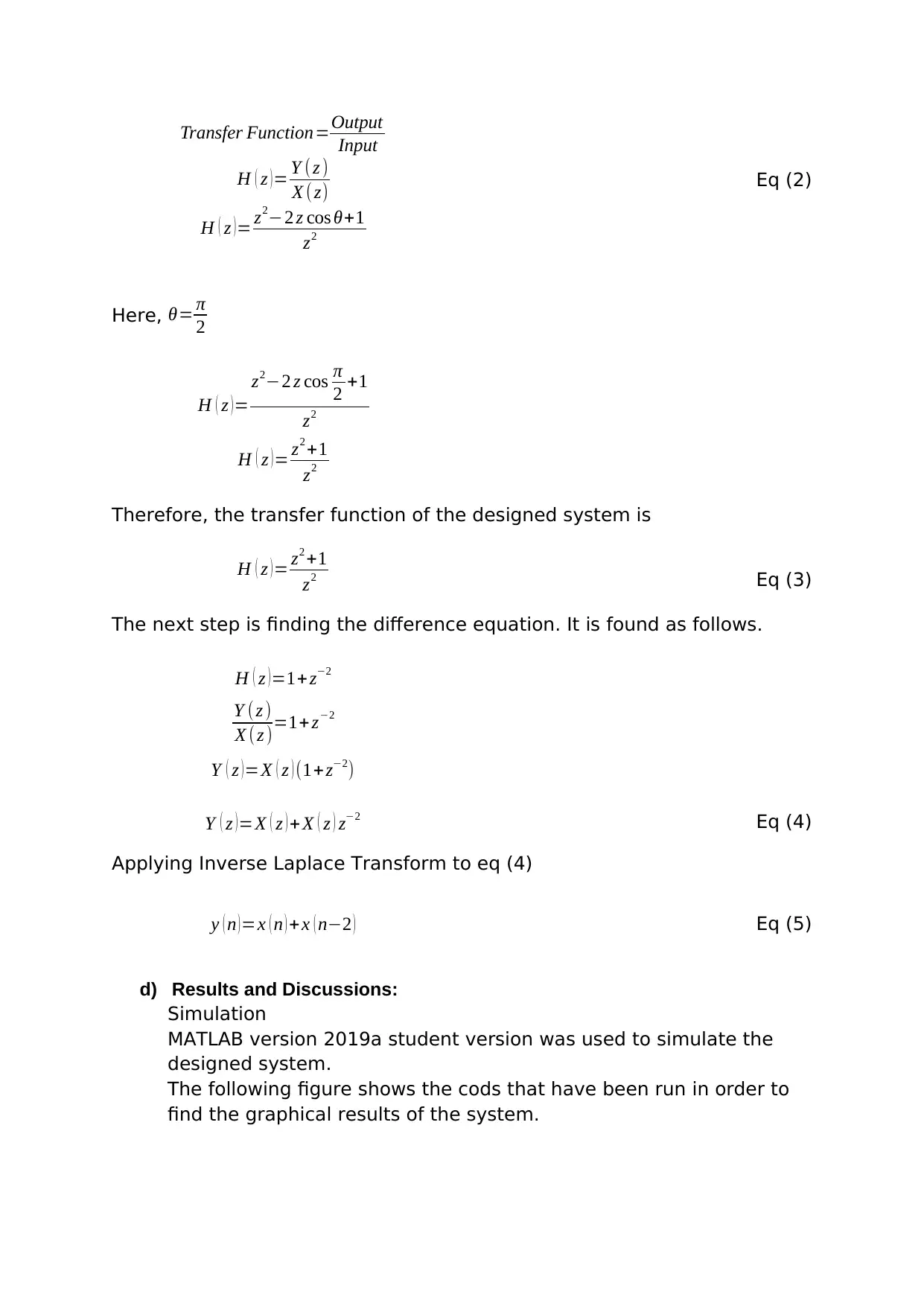
Transfer Function=Output
Input
H ( z )= Y ( z )
X ( z) Eq (2)
H ( z ) = z2−2 z cos θ+1
z2
Here, θ= π
2
H ( z )=
z2−2 z cos π
2 +1
z2
H ( z )= z2 +1
z2
Therefore, the transfer function of the designed system is
H ( z )= z2 +1
z2 Eq (3)
The next step is finding the difference equation. It is found as follows.
H ( z )=1+z−2
Y (z )
X ( z )=1+ z−2
Y ( z )=X ( z ) (1+z−2)
Y ( z )=X ( z ) + X ( z ) z−2 Eq (4)
Applying Inverse Laplace Transform to eq (4)
y ( n )=x ( n ) + x ( n−2 ) Eq (5)
d) Results and Discussions:
Simulation
MATLAB version 2019a student version was used to simulate the
designed system.
The following figure shows the cods that have been run in order to
find the graphical results of the system.
Input
H ( z )= Y ( z )
X ( z) Eq (2)
H ( z ) = z2−2 z cos θ+1
z2
Here, θ= π
2
H ( z )=
z2−2 z cos π
2 +1
z2
H ( z )= z2 +1
z2
Therefore, the transfer function of the designed system is
H ( z )= z2 +1
z2 Eq (3)
The next step is finding the difference equation. It is found as follows.
H ( z )=1+z−2
Y (z )
X ( z )=1+ z−2
Y ( z )=X ( z ) (1+z−2)
Y ( z )=X ( z ) + X ( z ) z−2 Eq (4)
Applying Inverse Laplace Transform to eq (4)
y ( n )=x ( n ) + x ( n−2 ) Eq (5)
d) Results and Discussions:
Simulation
MATLAB version 2019a student version was used to simulate the
designed system.
The following figure shows the cods that have been run in order to
find the graphical results of the system.
⊘ This is a preview!⊘
Do you want full access?
Subscribe today to unlock all pages.

Trusted by 1+ million students worldwide

Pole-Zero Plot: The figure shown below is the pole zero plot of the above
obtained transfer function. The pole is present at the origin and two zeros
are lie on the imaginary axis.
obtained transfer function. The pole is present at the origin and two zeros
are lie on the imaginary axis.
Paraphrase This Document
Need a fresh take? Get an instant paraphrase of this document with our AI Paraphraser
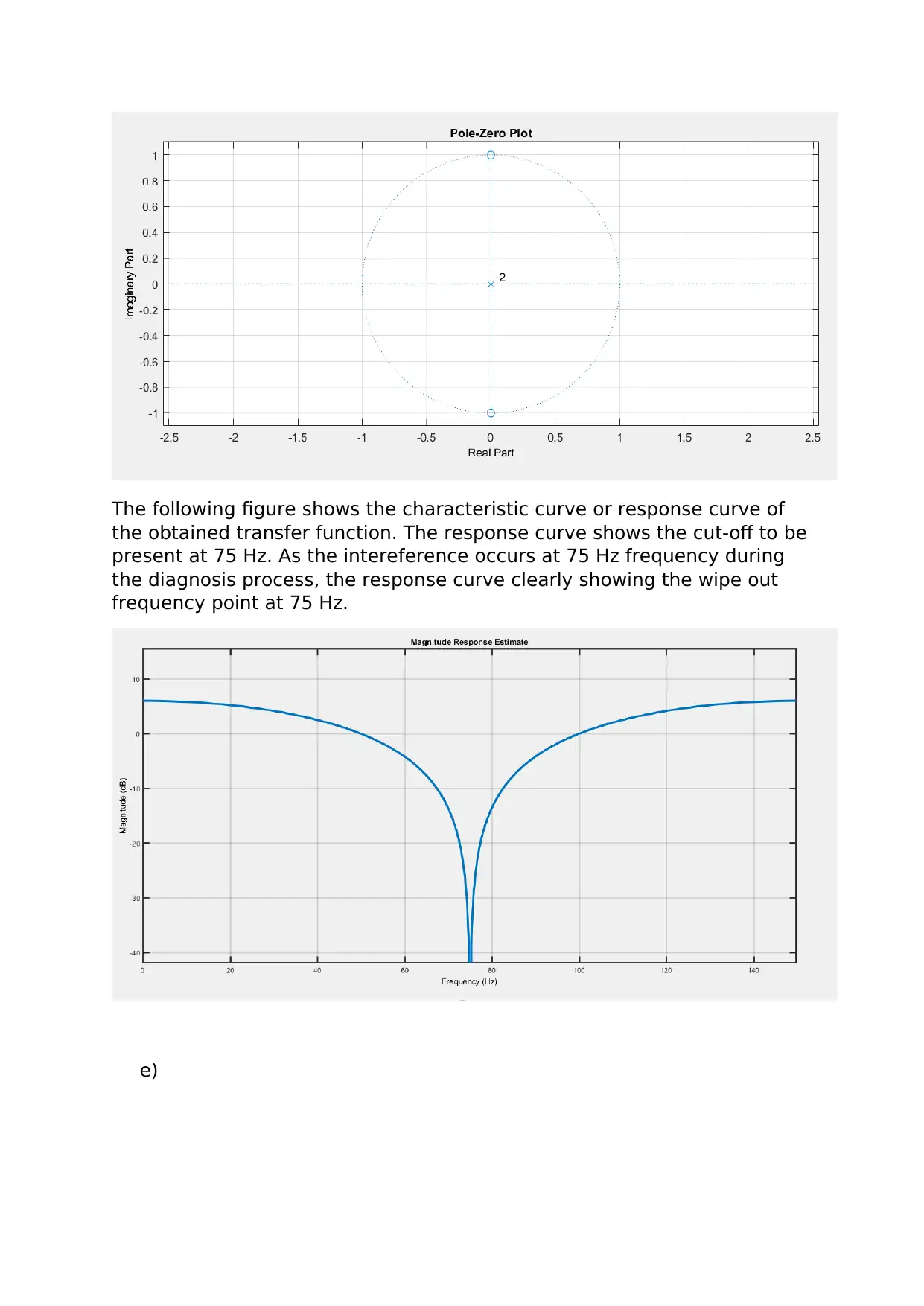
The following figure shows the characteristic curve or response curve of
the obtained transfer function. The response curve shows the cut-off to be
present at 75 Hz. As the intereference occurs at 75 Hz frequency during
the diagnosis process, the response curve clearly showing the wipe out
frequency point at 75 Hz.
e)
the obtained transfer function. The response curve shows the cut-off to be
present at 75 Hz. As the intereference occurs at 75 Hz frequency during
the diagnosis process, the response curve clearly showing the wipe out
frequency point at 75 Hz.
e)
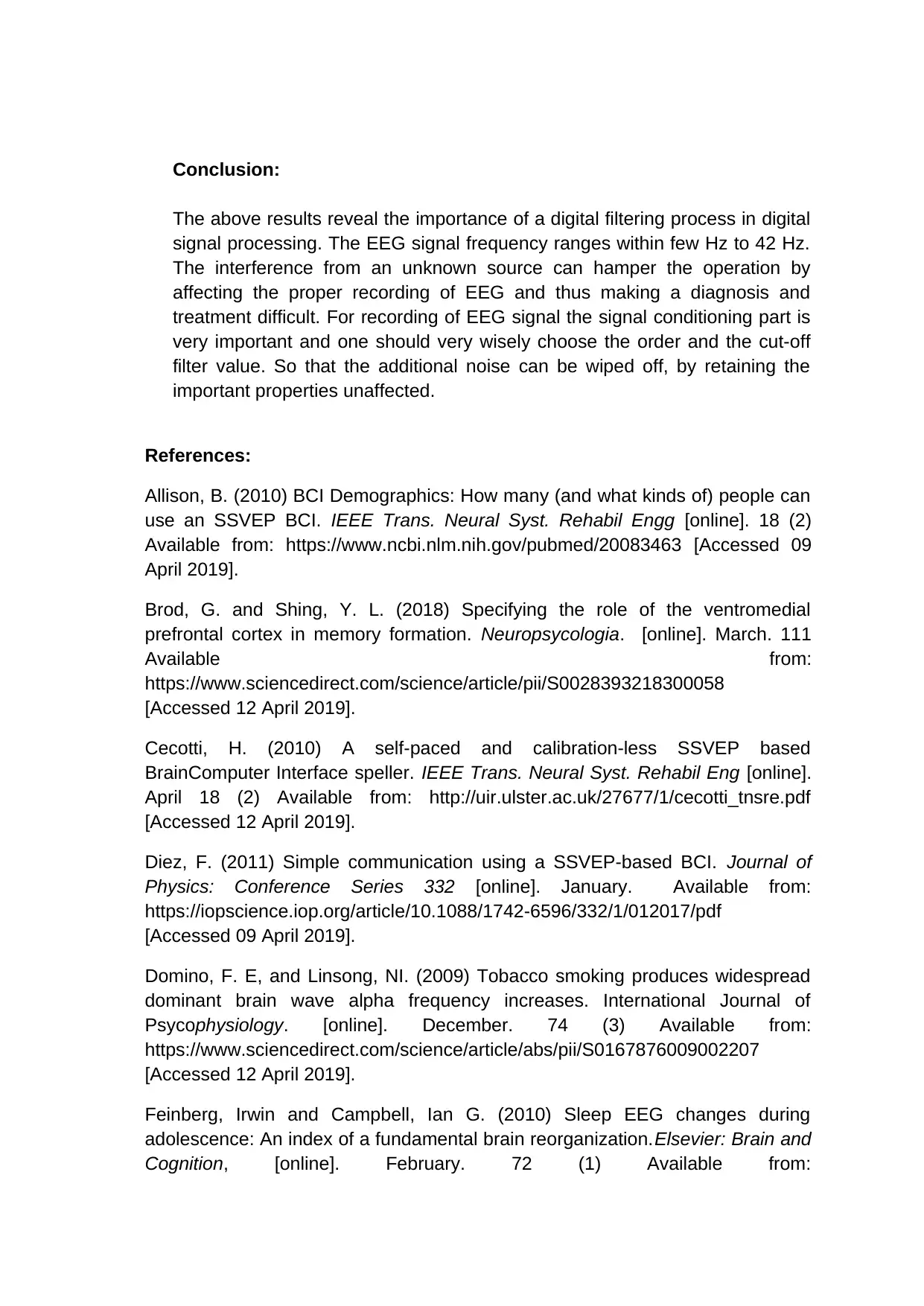
Conclusion:
The above results reveal the importance of a digital filtering process in digital
signal processing. The EEG signal frequency ranges within few Hz to 42 Hz.
The interference from an unknown source can hamper the operation by
affecting the proper recording of EEG and thus making a diagnosis and
treatment difficult. For recording of EEG signal the signal conditioning part is
very important and one should very wisely choose the order and the cut-off
filter value. So that the additional noise can be wiped off, by retaining the
important properties unaffected.
References:
Allison, B. (2010) BCI Demographics: How many (and what kinds of) people can
use an SSVEP BCI. IEEE Trans. Neural Syst. Rehabil Engg [online]. 18 (2)
Available from: https://www.ncbi.nlm.nih.gov/pubmed/20083463 [Accessed 09
April 2019].
Brod, G. and Shing, Y. L. (2018) Specifying the role of the ventromedial
prefrontal cortex in memory formation. Neuropsycologia. [online]. March. 111
Available from:
https://www.sciencedirect.com/science/article/pii/S0028393218300058
[Accessed 12 April 2019].
Cecotti, H. (2010) A self-paced and calibration-less SSVEP based
BrainComputer Interface speller. IEEE Trans. Neural Syst. Rehabil Eng [online].
April 18 (2) Available from: http://uir.ulster.ac.uk/27677/1/cecotti_tnsre.pdf
[Accessed 12 April 2019].
Diez, F. (2011) Simple communication using a SSVEP-based BCI. Journal of
Physics: Conference Series 332 [online]. January. Available from:
https://iopscience.iop.org/article/10.1088/1742-6596/332/1/012017/pdf
[Accessed 09 April 2019].
Domino, F. E, and Linsong, NI. (2009) Tobacco smoking produces widespread
dominant brain wave alpha frequency increases. International Journal of
Psycophysiology. [online]. December. 74 (3) Available from:
https://www.sciencedirect.com/science/article/abs/pii/S0167876009002207
[Accessed 12 April 2019].
Feinberg, Irwin and Campbell, Ian G. (2010) Sleep EEG changes during
adolescence: An index of a fundamental brain reorganization.Elsevier: Brain and
Cognition, [online]. February. 72 (1) Available from:
The above results reveal the importance of a digital filtering process in digital
signal processing. The EEG signal frequency ranges within few Hz to 42 Hz.
The interference from an unknown source can hamper the operation by
affecting the proper recording of EEG and thus making a diagnosis and
treatment difficult. For recording of EEG signal the signal conditioning part is
very important and one should very wisely choose the order and the cut-off
filter value. So that the additional noise can be wiped off, by retaining the
important properties unaffected.
References:
Allison, B. (2010) BCI Demographics: How many (and what kinds of) people can
use an SSVEP BCI. IEEE Trans. Neural Syst. Rehabil Engg [online]. 18 (2)
Available from: https://www.ncbi.nlm.nih.gov/pubmed/20083463 [Accessed 09
April 2019].
Brod, G. and Shing, Y. L. (2018) Specifying the role of the ventromedial
prefrontal cortex in memory formation. Neuropsycologia. [online]. March. 111
Available from:
https://www.sciencedirect.com/science/article/pii/S0028393218300058
[Accessed 12 April 2019].
Cecotti, H. (2010) A self-paced and calibration-less SSVEP based
BrainComputer Interface speller. IEEE Trans. Neural Syst. Rehabil Eng [online].
April 18 (2) Available from: http://uir.ulster.ac.uk/27677/1/cecotti_tnsre.pdf
[Accessed 12 April 2019].
Diez, F. (2011) Simple communication using a SSVEP-based BCI. Journal of
Physics: Conference Series 332 [online]. January. Available from:
https://iopscience.iop.org/article/10.1088/1742-6596/332/1/012017/pdf
[Accessed 09 April 2019].
Domino, F. E, and Linsong, NI. (2009) Tobacco smoking produces widespread
dominant brain wave alpha frequency increases. International Journal of
Psycophysiology. [online]. December. 74 (3) Available from:
https://www.sciencedirect.com/science/article/abs/pii/S0167876009002207
[Accessed 12 April 2019].
Feinberg, Irwin and Campbell, Ian G. (2010) Sleep EEG changes during
adolescence: An index of a fundamental brain reorganization.Elsevier: Brain and
Cognition, [online]. February. 72 (1) Available from:
⊘ This is a preview!⊘
Do you want full access?
Subscribe today to unlock all pages.

Trusted by 1+ million students worldwide
1 out of 14
Your All-in-One AI-Powered Toolkit for Academic Success.
+13062052269
info@desklib.com
Available 24*7 on WhatsApp / Email
![[object Object]](/_next/static/media/star-bottom.7253800d.svg)
Unlock your academic potential
Copyright © 2020–2025 A2Z Services. All Rights Reserved. Developed and managed by ZUCOL.
